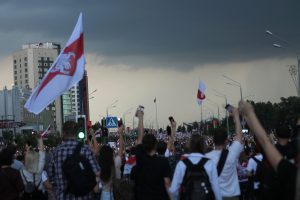Uncharted waters: Presidential successions in Kazakhstan and Uzbekistan

Popular legend holds that the 18th century French King, Louis XV, claimed that after his death everything would fall apart (après moi, le déluge). To outsiders, a similar uncertainty surrounds Kazakhstan and Uzbekistan to some extent, because they are both led by presidents that have been in power since 1989, even before their respective countries became independent in 1991. Nursultan Nazarbayev (74) of Kazakhstan and Islam Karimov (77) of Uzbekistan have established and maintained a firm grip on their countries, but have not indicated who might succeed them in the future. Both states are authoritarian and seek regional leadership. Kazakhstan is renowned for its natural resource-driven economic growth and international flair, and is often seen as the region’s economic engine. Uzbekistan is the most populous country in Central Asia and has a strong security sector compared to neighbours that includes relatively capable armed forces and an influential intelligence community.
- In both Kazakhstan and Uzbekistan, the smoothness of the presidential successions will depend to a large degree on the redistribution of economic resources among political and business elites.
- As new leaders will lack the clout of their predecessors they will likely seek consensus, potentially leading to some reform of state institutions, economic liberalisation but also rising nationalist sentiment.
- Nation-wide revolts cannot be excluded, but presidential succession processes are more likely to be upset by disaffected elite members supporting local social-economic protests.
Obviously, presidential succession is unavoidable at some stage in both countries. Kazakhstan is supposed to have presidential elections in 2016, and Uzbekistan postponed its presidential elections from December 2014 to March 2015. These dates can be delayed or brought forward as both leaders see fit (and they may or may not decide to run again), or succession could also occur in the form of a handover of power (à la Yeltsin to Putin in Russia in 1999). Neighbouring republics and international partners of both countries have little clue of what scenarios may unfold, but are very aware of the crucial security and economic roles both countries play in the Central Asian region – and the potential for unrest and instability that could surface during a period of regime change. In the case of Kazakhstan, this holds true in relation to the export of hydrocarbons and uranium as well as large outside investment in the country. It is also a crucial partner in Russia’s Eurasian Union plans. In Uzbekistan’s case, neighbours and regional partners see the country as a linchpin of the region’s security due to its booming demography, strategic weight and central location in Central Asia.
This brief does not seek to gaze in crystal balls on what might exactly happen and when. Nor does it discuss names of potential successors being voiced locally. Even if Kazakh and Uzbek political cultures have been marked by presidential cults of personality, at stake is not a person but a broader regime. This paper looks at how the mechanisms of power-sharing that have developed over the last two decades in both countries may change, and the evolving role of broader populations.
Elites and the distribution of resources
The principal driver of intra-elite stability is resource sharing. In most post-Soviet republics, the relationship between governments and business is intimate. The presidential successions in Kazakhstan and Uzbekistan will largely be decided through resource distribution, which could create tensions within the regime elites and the broader local business communities.
Kazakhstan’s state structures are more decentralised than those of Uzbekistan, and the group of elites is bigger and more diverse – elites here meaning people linked to the presidential family, oligarchs and powerful bureaucrats. During the 2000s – alongside a concentration of state power – the re-nationalisation of major assets around the Samruk-Kazyna fund and stock company (which includes 400 of the largest companies representing 60 per cent of Kazakhstan’s GDP) has served the personal aims of the Nazarbayev family, in particular the son-in-law of the president, Timur Kulibayev. But the wealth accumulated outside this state structure is equally significant. The country has private enterprise oligarchs in the mining sector who benefit from the personal protection of the president and often belong to national minorities (Jewish Russians, Koreans, etc.). Other oligarchs have made their fortune in ‘new sectors’ that emerged with the transition to a market economy such as the finance and banking sector, communications, and agribusiness. Some of these elites are opposed to control by the Nazarbayev family or to specific (non-ethnic Kazakhstani) oligarchs and have the potential to mobilise sections of the public opinion, in particular around a nationalist agenda.
Kazakhstan also has an influential bureaucratic elite. Its power base lies in its ability to distribute state resources to the private sector and to regional authorities; to control the appointment of cadres; manage relations with other countries; and steer the ideological direction of the regime. Officials can also boast their own financial base, since high-ranking public office makes it possible to place family members in key positions in small- or medium-size businesses. Indeed, this part of the elite has greatly contributed to the emergence of upper and middle-classes whose financial prowess is intrinsically linked to the development of a services sector (trade, entertainment, and high-tech). However, elites from the security sector are less powerful than in neighbouring Uzbekistan.
Uzbekistan has an even more centralised state structure but with limited profit-making opportunities. The Uzbek state has powerful ability to suppress opposition from within or outside state structures, and to make sure business follows suit or is absorbed by the state. But Tashkent is weak at imposing changes on regional elites (who control the agricultural workforce) and delivering public services to the broader population. The presidential family has ruled Uzbekistan with an iron fist, and the president’s eldest daughter, Gulnara Karimova, managed to appropriate most of the profitable sectors of the national economy, ranging from gas exports and mineral extractions to cement factories and the entertainment sector. Her empire was negotiated with the security services, which are essentially a state within the state, and have themselves also built up a commercial empire, based on control of export of commodities through taxes and customs.
Whereas the regime remains in full control of the country, internal power shifts have occurred. Since 2010, Karimova’s empire has been largely dismantled. Her main firm Zeromax was dissolved; judicial pressures have been mounting through the arrest of her close associates; and reports have surfaced claiming that she has been mistreated by security services and put under house arrest. The rise and fall of Karimova, and other ongoing squabbles over property rights, suggest that the intra-elite equilibrium is probably less stable than the regime’s level of control over the country would suggest.
A key difference between the two countries is that Kazakhstan has a powerful bureaucratic elite with economic interests, whereas Uzbekistan instead has a security sector that wields substantial power with its own commercial empire. In both countries the distribution of resources established during the first two decades of independence could be challenged by presidential succession or vice versa. Some stakeholders are more susceptible to losing out than others: in Kazakhstan, for instance, the oligarchs belonging to national minorities are protected by Nazarbayev but risk being quickly challenged by Kazakhstani oligarchs and the state bureaucracy; in Uzbekistan, those that are close to Karimov’s daughters and who have not managed to ally themselves with other stakeholders are also at risk. Clearly all actors will attempt to secure their influence, and new alliances may quickly emerge. None of the actors fully controls the game, nor do they know in advance if their assets under a new leadership will be protected or threatened.
Institution-building and economic liberalisation – how the current elites may maintain stability
Future presidential successions are about more than an internal redistribution of assets to privileged groups. Both countries are in the run-up to their first leadership change, so the process could also affect the institutional design of both states.
Kazakhstan has just started a process of institution-building accompanied by modest institutional reform. The objective is to create state institutions that are more amenable to political reform once Nazarbayev’s rule is over. For example, the parliament’s powers have in theory been augmented, while the presidential party, Nur-Otan, has sought to develop into a more ambitious political organisation. The goal of Nur-Otan is no longer only to reap votes during elections, but also to shape political life and the state structure as a whole. The idea of a ‘collective successor’ that would be selected through consensus has been advanced by several experts recently and was discussed by the Nur-Otan Party Secretary Erlan Karin in May 2012.
The notion of such a ‘collective successor’, even if not endorsed publicly by the authorities, can be seen as a symbol of the elite’s desire to depersonalise the succession process, and could announce the country’s potential for political modernisation. Emerging political awareness that the regime must undergo institutional reform and development goes hand-in-hand with the rising influence of post-independence generations, for whom Nazarbayev is the embodiment of an outdated post- Soviet paradigm. It is mostly the bureaucratic elites, often educated abroad, as well as medium and small business circles, that aspire for stronger and better regulated institutions and clear rules for power-sharing. It is difficult to predict if such a consensus process on the selection of the new leadership would also be accompanied by elements of genuine democratisation, including a multi-party system and real checks and balances such as parliamentary oversight and an increasingly independent judiciary. More likely, the ‘collective successor’ would seek to maintain a relatively similar regime to the one in place today. Still, if a ‘collective successor’ is accompanied by some institutional reform and development, such an arrangement could improve the business environment and stimulate a more independent legal framework.
The situation is more opaque in Uzbekistan. Here too, no successor is likely to enjoy the same legitimacy as Karimov – the ‘father of the nation’ – and will therefore have to make more far-reaching compromises with other elite stakeholders. There is some prospect for increased institutional reform, though less than in Kazakhstan. Recent constitutional amendments that transfer some powers from president to prime-minister and earlier efforts to strengthen the role of the parliament point in this direction. But the country lacks a young, ambitious and well-educated bureaucratic elite able to guide reform. Also, rent-seeking opportunities are fewer in Uzbekistan compared to Kazakhstan: Uzbek wealth essentially derives from a few major industries and resources – foremost cotton, gold, uranium and hydrocarbons – while privatised sectors remain limited.
However, a simple continuation of the mechanisms in place under Karimov seems unlikely. The current regime may struggle to keep all elite stakeholders satisfied as the current political system limits the growth potential of existing economic assets in the coming years. Moreover, one source of income for the regime
- fees generated through the Northern Distribution Network and the Termez airbase used by NATO allies for the war in Afghanistan
- will largely evaporate following NATO’s drawdown from Afghanistan. Karimov’s successor may therefore aim towards economic liberalisation to attract more foreign investment and open new niches of wealth redistribution to satisfy the elites.
This type of change took place in Turkmenistan from 2007 onwards, where President Gurbanguly Berdymukhammedov gradually allowed a larger group of Turkmen elites to profit from the gas revenues: basically he increased the number of winners resulting from the change in order to make up for his lack of personal legitimacy. In Uzbekistan, however, relations among stakeholders are more complex. The predatory habits of the security services will be difficult to manage and normalise, and the attitude of the regional elites will be an uncertain factor as well – marginalisation of, for instance, the elites from the Fergana Valley could bring a new element of uncertainty into the succession process.
The influence of the public – limited but potentially important
Even in harsh dictatorships the opinion of the population plays a role, in support or at odds with the regime. At first sight, public opinion seems broadly supportive of the Kazakh and Uzbek regimes, although (especially in Uzbekistan) opinion polls cannot be trusted since an element of fear plays a role. In Kazakhstan, Nazarbayev enjoys broad support, in part for placing the country on the international map. In Uzbekistan, the regime has played the nationalist card effectively, having become part and parcel of the population’s general adherence to post-Soviet national symbols and identity.
However, with regard to public acceptance of the regimes, Kazakhstan is more fragile than Uzbekistan. The official narrative of Kazakhstani identity, which largely embraces ethnic minorities and marginalises the notion of ‘Kazakhness’, could be easily undermined by a new generation, for many of whom a more modern and operational state should also be a more ethnically Kazakhstani one. Such a state would do away with Soviet rhetoric of friendship between peoples, and would potentially be less pro- Russian than the current one. In both countries, it is likely that successors will have to play the symbolic card of nationalism to compensate for their lack of ‘father of the nation’ status.
The population will not be called upon to participate in the presidential succession unless it takes the form of fully-controlled elections to keep up democratic appearances, while the president may already be in power having been selected by the elites. The broader population’s interest in political life is low, plus the idea that the state is an object of dispute between elites rather than a distributor of the common good is broadly shared. No opposition movement has the legitimacy, ideology, or leaders to scupper intra-elite negotiations on future succession processes. Islamist movements such as Hizb ut-Tahrir, which aim to change society bottom-up through Islamisation, could eventually gain influence but not through direct political engagement for the time being. In both countries, there have been irregular protests against local authorities regarding decisions related to agricultural production, energy shortage or closures of small businesses. But these protests, such as in Kazakhstan’s Zhanaozen in 2011 when oil workers went on strike, do not have an elaborated ideological base, nor a national scope.
This does not mean that a conjunction between discontented elites and popular grievances cannot occur and form the basis of a new political force that will impact the successions, as the combination of revolts and regime changes in Kyrgyzstan in 2005 and 2010 shows. In Kazakhstan – and to a lesser extent in Uzbekistan – some elites might be prepared to use popular discontent to ensure their voices are heard in the capital. As the 2011 protests in Tunisia and Libya showed, a popular movement can quickly emerge based on socio-economic demands (wages, pensions and remittances, energy shortages, housing issues) or on questions of social justice – for example, in Uzbekistan protests followed the seizure of a local private business by the authorities in Andijan in 2005. But the political reformulation of Kazakh or Uzbek protests (regime change, improvement of the legal climate) would probably take longer than in Tunisia and Libya, and would likely be carried forward by the current elites. Meanwhile, a popular revolt that is largely brought about by a new generation of disillusioned youth seems unlikely in both countries, in part because access to internet is fairly low (though access is higher in Kazakhstan compared to Uzbekistan).
Last, there is a chance of violence, based on a radical Islamist narrative, impacting presidential successions. Whereas a violent coup d’état by Islamic radicals is unlikely due to a lack of popular support and nationwide organisational capacity, there could be isolated incidents that could affect the succession processes. For instance, Uzbekistan could face an Islamist insurgency in parts of the Fergana Valley, while Kazakhstan has experienced suicide attacks in Western regions where Jihadist cells have gained strength. However, both states have relatively well organised and equipped security forces, and would probably be able to contain such events.
Conclusion
The current political circumstances in Kazakhstan and Uzbekistan show a lot of similarities – aging ‘father of the nation’ presidents, strong authoritarian regimes – but there are also important differences in their prospects for smooth successions.
Kazakhstan is an economic powerhouse and Uzbekistan a controlled economy. Kazakhstan should, at first glance, have an easier job appeasing elites and the broader population in economic terms, but there are also more resources for national and regional elites to fight over. In Uzbekistan there is less to divvy up, which could exacerbate already existing squabbles among elites and with the national security forces, or could encourage an intra-elite consensus to maintain the existing rent- seeking mechanisms.
Both countries could opt for a consensus successor and work towards more predictable regulation of elite interests. In Kazakhstan, this process is already underway and could eventually lead to sparks of democratisation, while in Uzbekistan it remains to be seen if the system can spur any reform. For Uzbekistan, the liberalisation of the economy will be essential to better share assets among elites and keep the peace. Due to the emergence of the post-Soviet generation, Kazakhstan could be prone to increased nationalist sentiment, while Uzbekistan already has a strong national identity that could turn into nationalism directed at minorities or neighbouring countries.
The population is largely excluded from the process but could play a marginal role if activated by existing elites for local and personal agendas though unlikely on a national basis. Islamisation of society is an irreversible bottom-up process that could eventually turn political, but unlikely to influence the future successions.
Instability and Ukraine-like features, including people demanding an end to corruption and steps towards democracy, cannot be excluded in the coming decade in Kazakhstan and Uzbekistan. Still, a stable reproduction of the system is a more likely scenario. Such a scenario will largely be built around the distribution of assets by the elites, some degree of institutional reform, economic liberalisation, and public consent based on increased nationalism and a basic level of social services provided by the state. The indicators that could lead to instability in both countries, such as a dissatisfied new generation and greater influence of Islam, are more likely to have an impact on successor regimes than distort the future succession processes in Kazakhstan and Uzbekistan.



![shutterstock_1240181551 [Omgezet]](https://eucentralasia.eu/wp-content/uploads/2024/10/shutterstock_1240181551-Omgezet-300x248.jpg)



